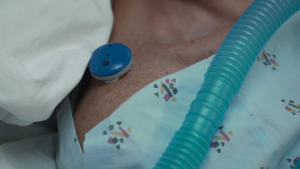Voxello and its clinical partners will be at ATIA in 2019 and will have two presentations on the docket.
 The first will highlight Voxello’s newest sensor, the min-mo (patent pending). Voxello, with support from the NIH-NINR, has developed the min-mo sensor that uses motion-sensing technology to detect a wide range of small intentional gestures (e.g. head nod, shoulder shrug, wrist roll). It can be used in a plug-and-play mode or can learn to recognize a patient’s particular gesture. The sensor is designed to be directly mounted to the patient so that patients can, regardless of their position in bed, be able to use the noddle to activate the nurse call system and control the noddle-chat communication tablet with speech generation. With the addition of this sensor, Voxello has expanded the range of patients that can more effectively summon their nurses providing greatly enhanced communication and participation in their care.
The first will highlight Voxello’s newest sensor, the min-mo (patent pending). Voxello, with support from the NIH-NINR, has developed the min-mo sensor that uses motion-sensing technology to detect a wide range of small intentional gestures (e.g. head nod, shoulder shrug, wrist roll). It can be used in a plug-and-play mode or can learn to recognize a patient’s particular gesture. The sensor is designed to be directly mounted to the patient so that patients can, regardless of their position in bed, be able to use the noddle to activate the nurse call system and control the noddle-chat communication tablet with speech generation. With the addition of this sensor, Voxello has expanded the range of patients that can more effectively summon their nurses providing greatly enhanced communication and participation in their care.
The second presentation showcases a series of case studies at the University of Wisconsin Hospitals and Clinics following implementation of the noddle® and the noddle-chat communication device for patients with complex communication needs. While the use of augmentative and alternative communication (AAC) strategies with outpatient populations is well established, it is not yet the standard of care for patients facing acute barriers to communication during a hospitalization. The presentation will describe the system barriers that must be overcome to incorporate AAC technology into clinical practice. The presented cases will highlight the need for interprofessional practice and describe the implementation strategies and ongoing problem-solving needed to meet the communication needs of hospitalized patients.
You can also see the latest Voxello technology at the ATIA conference.
